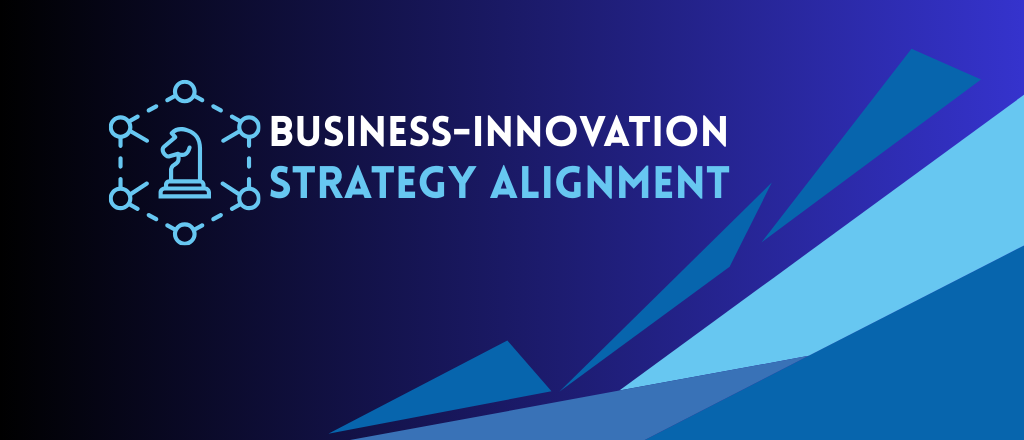Six Steps for Sustained Success
In today’s highly competitive business landscape, organizations must constantly innovate to stay ahead. However, innovation for the sake of innovation can lead to wasted resources and missed opportunities. To maximize impact and drive sustainable growth, businesses must align their innovation strategy with their overarching business strategy. This strategic alignment ensures that every innovation effort contributes directly to the company’s long-term goals, enhances competitiveness, and delivers tangible business value.

Understanding Business and Innovation Strategy
A business strategy outlines an organization’s long-term vision, market positioning, competitive advantage, and revenue gro wth plans. It provides a roadmap for decision-making and resource allocation to achieve specific goals.
An innovation strategy, on the other hand, defines how a company leverages creativity, technology, and new processes to develop unique solutions, products, or services. It involves research and development (R&D), idea management, long-term horizon research, technology ventures (or scouting) and understanding markets to identify possible market disruptions. A well-crafted innovation strategy not only guides internal initiatives but also encourages organizations to remain attuned to evolving customer needs and emerging trends. By proactively listening to customer feedback and conducting thorough market research, businesses can uncover pain points in existing systems—whether in traditional queue management, online portals, or physical service areas. This approach enables organizations to seize opportunities presented by the growing demand for self-service and digital-first experiences. Furthermore, as industries increasingly shift toward online and mobile-based services, aligning innovation strategy with modernization efforts becomes essential. This alignment drives improved customer experiences, positions the organization to capitalize on new opportunities, and ensures that innovation efforts remain closely tied to overall business objectives.<br />
The Role of Iterative Improvement in Innovation
A key component of any effective innovation strategy is the practice of iterative improvement. This approach centers on the continuous refinement of ideas, processes, and solutions by gathering feedback, analyzing performance, and making targeted adjustments over time.
Rather than pursuing a one-and-done solution, organizations such as Apple and Toyota have thrived by systematically improving their offerings in response to customer input and evolving market dynamics. Iterative improvement enables businesses to quickly identify what works, address shortcomings, and pivot in alignment with both user needs and technology trends.
Through frequent cycles of testing and adjustment, companies can:
- Respond swiftly to changing customer expectations
- Embrace new technologies without overhauling entire systems
- Reduce the risk of innovation missteps by learning from each round of feedback
- Maintain momentum and relevance in a rapidly shifting marketplace
Ultimately, this dynamic process not only drives better results but also fosters a culture where ongoing optimization becomes a natural part of strategic execution.
The Role of Prototyping and Testing in Driving Innovation
Prototyping and testing play a pivotal role in bridging the gap between bold ideas and business results. By creating early models of new solutions—whether it’s a digital platform, a physical device, or an innovative process—organizations can bring concepts to life quickly and cost-effectively. This approach allows teams to explore usability, gather actionable feedback, and uncover unforeseen challenges before investing heavily in full-scale development.
Pilot programs, much like the strategies employed by industry leaders such as Apple or Amazon, further refine innovation efforts. By launching new solutions in select environments, businesses can capture real-world input from both employees and customers. This direct feedback loop informs further iterations, ensuring that each improvement is not just theoretical but grounded in everyday use and customer expectations.
Ultimately, this iterative cycle of prototyping and testing enables organizations to remain agile and responsive. Rather than waiting for a “perfect” launch, companies adapt their offerings in real time, staying aligned with market shifts and emerging customer needs. It’s this hands-on, adaptive process that transforms creative ideas into practical innovations—powering business growth and long-term success.
Why Alignment Matters
- Enhanced Competitive Advantage
When innovation aligns with business objectives, companies can create differentiated products and services that resonate with their target market. A strategic approach to innovation allows businesses to anticipate industry trends, address customer pain points, and maintain a leadership position. - Efficient Resource AllocationInnovation initiatives require investments in technology, talent, and infrastructure. Aligning innovation with business strategy ensures that resources are directed toward projects that offer the highest return on investment and drive meaningful business impact.
- Improved Market Relevance
Innovation without strategic alignment can lead to products or services that lack market demand. Companies that integrate their innovation efforts with business goals can develop solutions that meet evolving customer needs, leading to higher adoption rates and revenue growth.
In addition to boosting market relevance, a well-thought-out innovation strategy can significantly enhance the customer experience. By adopting new technologies and forward-thinking practices—such as virtual queueing systems to minimize wait times or mobile support to provide real-time assistance—businesses can offer more personalized and efficient services. This not only increases customer satisfaction and loyalty but also generates positive word-of-mouth, fueling further business growth.- Faster Decision-Making
A clear connection between innovation and business strategy simplifies decision-making. Leaders can prioritize projects that align with the company’s vision and discontinue initiatives that do not support long-term objectives, reducing wasted time and effort. Furthermore, decisions can be based on clear ROI expectations directly tied to new products or product enhancements.
- Sustainable Growth
Short-term innovation wins may generate buzz, but sustainable success requires a long-term vision. By integrating innovation into the business strategy, companies ensure that they continue evolving while maintaining financial stability and operational efficiency.
- Long-Term Research
The innovation team can perform long-term research with a clear understanding of how newly identified emerging technologies can either impact their business or serve as a disruptor to the company’s competition. Such information can be presented to the business to possibly influence the direction of the business unit’s strategic direction.
Aligning Organizational Structure and Procedures
Successful innovation goes beyond great ideas—it requires a solid foundation within the organization itself. This means aligning internal structures and day-to-day procedures so that new technologies and processes fit seamlessly into current operations, rather than disrupt them.
For example, integrating self-service kiosks or digital queue management systems into existing customer service processes can help enhance the customer experience without causing operational headaches. To ensure this alignment:
- Standard operating procedures and training materials are updated to reflect any changes, so employees know exactly how to interact with new systems.
- Clear governance structures and accountability mechanisms are put in place, helping to manage ongoing innovation efforts smoothly.
- Business strategy and innovation become tightly connected, making implementation more effective and reducing the risk of missteps.
By prioritizing this organizational alignment, companies can ensure that their innovation efforts not only spark excitement but also deliver sustainable business value over time.
- Improved Market Relevance
Leveraging Data-Driven Insights for Smart Innovation Decisions
By harnessing real-time monitoring and robust analytics, organizations gain valuable visibility into key metrics—such as team productivity, customer behavior patterns, and market engagement. This empowers leaders to make faster, evidence-based decisions rather than relying on gut instinct or outdated reports.
For example, companies like Procter & Gamble and Ford use comprehensive data dashboards to track the success of pilot programs or product rollouts, allowing them to quickly pivot strategies if early results indicate the need for adjustments. With data-driven insights in hand, innovation teams can:
- Identify underperforming initiatives early, preventing resource drain.
- Pinpoint customer touchpoints ripe for improvement or automation.
- Reveal trends in market demand, helping teams prioritize high-impact projects.
Ultimately, integrating real-time data collection and analysis into the innovation process ensures that every step, from brainstorming to launch, is informed by actionable intelligence. This not only drives efficiency but also minimizes risk—directly connecting innovation activities to tangible business outcomes.
Real-World Examples of Innovation Driving Strategic Success
To better understand how innovation strategy fuels business outcomes, let’s look at how leading organizations have put these principles into action:
- Transforming Customer Experience at Scale
Major telecommunications providers in the Middle East, faced with tens of thousands of retail points, have overhauled their customer service approach by embracing technology. By introducing digital queue management systems and self-service kiosks, these companies not only streamlined customer flow but also made core services—like SIM sales, bill payment, and account management—far more accessible and efficient. This resulted in measurable boosts to customer satisfaction and retention. - Data-Driven Decisions for Operational Excellence
With the implementation of real-time monitoring tools, telecom operators have gained actionable insights into foot traffic, staff allocation, and transaction patterns. These data analytics capabilities have empowered managers to optimize resource deployment, respond dynamically to changing demand, and ultimately make decisions that align closely with both business objectives and market needs. - Strategic Partnerships for Continuous Improvement
By collaborating with technology solution providers and integrating innovative platforms, organizations have dramatically improved their ability to scale, adapt, and maintain a competitive edge. The shift has fostered a culture where innovation isn’t viewed as an isolated project, but as a core, long-term business driver.
These examples demonstrate that deliberate, strategically aligned innovation is not just about new gadgets or novel ideas. It’s about pursuing advancements that deliver sustained business value, operational improvements, and a superior customer experience.
Steps to Align Innovation Strategy with Business Strategy
1
Define Clear Business Goals
Start by identifying the company’s key objectives- whether it’s expanding into new markets, increasing profitability, or enhancing customer experience. These goals should serve as a foundation for innovation initiatives.
2
Develop a Cohesive Innovation Framework
Establish an innovation strategy that supports business objectives. This includes defining the types of innovation to pursue (e.g., incremental, disruptive, or breakthrough) and setting key performance indicators (KPIs) to measure success.
To ensure your innovation efforts remain effective, consistently monitor and measure outcomes using well-chosen KPIs—such as customer satisfaction scores, average wait times, or service efficiency—tailored to your business goals. Implement real-time monitoring tools and data collection processes to capture system performance and user feedback.
By regularly analyzing this data, organizations can pinpoint what’s working, identify areas for improvement, and swiftly adapt strategies as needed. This continuous review keeps innovation initiatives relevant, ensures alignment with your overarching business strategy, and enables your teams to stay agile in the face of changing customer needs or market trends.
3
Encourage Cross-Functional Collaboration
Innovation should not be confined to R&D teams (see Ezassi’s blog on the Kaizen Approach for Product Lifecycle Management). Involve stakeholders from various departments—marketing, finance, operations, and customer service—to ensure a holistic approach that aligns with business priorities.
Equally important is engaging frontline employees and other key stakeholders throughout the innovation process. By involving team members from the outset, companies can address concerns early, encourage buy-in, and pave the way for smoother implementation. Open communication helps employees and customers alike understand the advantages of new solutions, making the significance and impact of these changes much clearer for everyone involved.
To further strengthen alignment, actively collect feedback from stakeholders at every stage. Listening to their insights and incorporating their suggestions allows organizations to make necessary adjustments and increases the likelihood of successful adoption. This collaborative, transparent approach not only reinforces the importance of innovation strategy but also helps create a positive work environment where new ideas can thrive.
4
Invest in the Right Technology and Talent
Businesses must equip teams with the right tools, technology, and skills to drive innovation. Investing in employee training and fostering a culture of continuous learning helps maintain alignment with business goals.
Encouraging innovation at every level—not just among leadership—ensures that all employees feel engaged in the process. By providing ongoing training and resources, organizations empower staff to adapt to new technologies and evolving processes with confidence. This approach not only makes employees comfortable with change but also helps them see how their contributions support the company’s broader objectives.
Promoting open knowledge sharing—where teams exchange insights and best practices—further strengthens a learning culture. As employees learn from one another, continuous improvement becomes ingrained in daily operations, accelerating innovation and supporting long-term business success.
5
Regularly Review and Adapt
Business and market conditions evolve, so companies must continuously reassess their innovation strategy to ensure it remains aligned with overarching goals. Regular reviews with the business can help identify areas for improvement and adjust strategies in real time.
Iterate for Continuous Improvement
Iterative improvement is essential for refining both solutions and the innovation strategy itself. Organizations that regularly monitor feedback—whether from internal teams or customers—and track system performance are better equipped to spot areas for growth. This ongoing evaluation allows companies to adapt quickly, ensuring solutions remain relevant even as customer needs shift and new technologies emerge.
By incorporating feedback loops and making incremental adjustments, businesses can keep their innovation efforts agile and responsive. This proactive approach not only sharpens competitive advantage, but also helps maintain alignment between innovation initiatives and broader business objectives.
6
Processes to Handle Incoming Requests
The innovation team will need to ensure that all types of incoming requests from the business can be efficiently handed off to the appropriate teams. For example, new ideas may enter the pipeline that require technical development or engineering, while others may require research on trends and emerging players of a new technology domain. Innovation pathways on the backend must be established to quickly handoff such requests for proper handling and execution.
Scaling Innovations Across the Organization
Once an innovation demonstrates clear value, the next challenge is thoughtfully scaling it throughout the organization. This step determines whether a new technology, process, or idea can truly transform business outcomes or simply remain a siloed success story.
Begin by crafting a detailed rollout plan that addresses how the innovation fits within diverse business environments—considering geography, customer segments, and branch types. Build cross-functional teams to shepherd the deployment process, tapping expertise from IT, operations, training, and frontline staff to ensure broad adoption. Draw on proven models, such as Apple’s systematized global retail rollouts or McDonald’s operational playbooks, to inform best practices.
Crucially, allocate adequate resources for not only initial implementation but also for ongoing support, training, and optimization. Robust integration with core systems (such as CRM, queue management tools, or analytics dashboards) underpins the scalability and sustainability of new solutions.
As innovations are scaled, continuously gather feedback from users and frontline staff. Use this insight to refine processes, adapt training, and address operational hiccups in real time. The result: a more resilient innovation pipeline capable of delivering measurable improvements in customer satisfaction, employee engagement, and overall organizational performance.
Aligning business strategy with innovation strategy is not just a best practice—it is a necessity for long-term success. When done effectively, it drives competitive advantage, optimizes resource utilization, enhances customer satisfaction, and fosters sustainable growth. Organizations that embrace this alignment will be better positioned to navigate market shifts, capitalize on emerging opportunities, and remain at the cutting edge of their respective industries.
Moreover, a well-aligned innovation strategy promotes adaptability and resilience, qualities that are increasingly essential in today’s rapidly changing environment. By embedding innovation into the core of business planning, companies are better equipped to respond to market shifts, economic fluctuations, and unforeseen challenges. This adaptability allows businesses to stay relevant and thrive—even in uncertain times—ensuring they can weather disruptions and emerge stronger on the other side.
Once the continuous source of business innovation needs is established as a legitimate pipeline process, new business, needs, ideas, opportunities and more can be processed efficiently to achieve maximum innovation potential (to learn more about this process, see Ezassi’s blog on Pipeline Management).

Aligning business strategy with innovation strategy is not just a best practice- it is a necessity for long-term success. When done effectively, it drives competitive advantage, optimizes resource utilization, enhances customer satisfaction, and fosters sustainable growth. Organizations that embrace this alignment will be better positioned to navigate market shifts, capitalize on emerging opportunities, and remain at the cutting edge of their respective industries.
Contact Ezassi to learn more about how to align your company’s business and innovation strategies and to create a roadmap for success.






